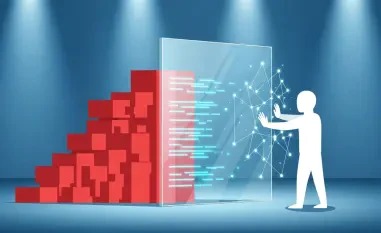In an era where cyber threats are becoming increasingly sophisticated and frequent, traditional perimeter-based security models are proving inadequate. The rise of cloud computing, mobile devices, and remote work has blurred the boundaries of corporate networks, necessitating a more robust and adaptive cybersecurity approach. Zero Trust Architecture (ZTA) emerges as a transformative model designed to counter contemporary cyber threats by operating on the principle, “never trust, always verify.”
The Shift from Traditional Security Models
Limitations of Perimeter-Based Security
Traditional security models rely heavily on defenses such as firewalls and intrusion detection systems to protect the network perimeter. These models assume that everything inside the corporate network is secure, which is no longer a valid assumption in today’s digital landscape. Attackers can easily exploit stolen credentials or compromised devices to move laterally within the network, facing minimal resistance. This inherent weakness in perimeter-based security has been exposed repeatedly, leading to increasingly severe breaches and data losses across industries.
The evolution of work environments requires security models that adapt to the complexities of modern network architectures. Exploiting single points of entry, attackers can traverse traditional networks almost unchecked, bypassing defenses with relative ease once inside. This realization has catalyzed the demand for more sophisticated and comprehensive security frameworks like ZTA, designed to ensure an organization’s digital assets remain secure, regardless of where or how they are accessed.
The Need for a New Approach
The increasing complexity of cyber threats and the evolving nature of work environments demand a shift from perimeter-based security to a more dynamic and resilient model. Zero Trust Architecture addresses these challenges by introducing multiple layers of verification and continuous monitoring, making unauthorized movements within the network significantly more difficult. In a Zero Trust model, each access request is evaluated in real-time, scrutinizing the context and device posture to determine legitimacy. This rigorous examination ensures that even if one layer of security is breached, additional checks will thwart unauthorized progression.
Moreover, the fundamental philosophy of Zero Trust—assuming no inherent trust for any entity, internal or external—aligns seamlessly with today’s dispersed digital ecosystems. By decentralizing and compartmentalizing security measures, ZTA mitigates risks associated with broad, unchecked access, offering a highly adaptive protective stance that aligns with modern organizational needs. The shift to a Zero Trust model not only fortifies an organization’s defense mechanisms but also instills a culture of vigilance and security-first thinking across the workforce.
Core Principles of Zero Trust Architecture
Constant Verification
At the heart of ZTA is the principle that no user, device, or application is trusted by default. This requires constant verification throughout a session, not just at the initial point of access. By ensuring that every interaction is authenticated and authorized, ZTA minimizes the risk of unauthorized access. In practice, this means implementing advanced authentication methods, such as multi-factor authentication (MFA) and adaptive access policies influenced by real-time analytics and behavior assessments.
Such a relentless commitment to verification creates an environment where trust must be continuously earned rather than assumed. Entities interact within a scrutinized framework, prompting authorization checks that include not just identity verification but also device health assessments and situational analysis. As cyber threats evolve, so too does the sophistication with which verification protocols are executed. Constant verification transforms reactive security into an anticipatory, proactive force against potential breaches.
Least Privilege Access
The principle of least privilege is meticulously applied in ZTA, ensuring that entities only have the minimal necessary access to perform their functions. This reduces the potential damage that can be caused by compromised credentials or insider threats. By confining access rights to what is essential for an entity’s role, Zero Trust minimizes pathways an attacker can exploit, isolating potential compromise to the smallest possible footprint within the network.
Implementing least privilege often requires a thorough auditing of current access controls and the elimination of unnecessary privileges. Each access level is critically evaluated, granting permissions tiered strictly on necessity. Automation plays a vital role in maintaining least privilege, with dynamic adjustments responding to real-time risk assessments. Strengthening this principle helps organizations not only prevent broad unauthorized access but also streamline compliance and risk management practices vital in regulated industries.
Micro-Segmentation
Micro-segmentation partitions the network into smaller, more manageable segments, restricting potential threats and allowing for granular security policies. This approach limits the spread of attacks and enhances the overall security posture of the organization. Within a micro-segmented network, each segment operates independently, protected by bespoke security protocols tailored to its specific needs and vulnerabilities. This isolation ensures that even if a segment is compromised, the breach is contained, preventing lateral movement to other network areas.
Developing an effective micro-segmentation strategy involves detailed mapping of network workflows and understanding data flows within the organization. Each segment’s unique requirements and risk profiles inform customized security policies, leading to higher efficiency and targeted protection. Integrating advanced analytics and machine learning helps refine segmentation, ensuring dynamic responsiveness to emerging threats and minimizing administrative overhead.
Enhancing Security with Encryption and Monitoring
End-to-End Encryption
End-to-end encryption safeguards data both in transit and at rest, further enhancing security. By encrypting data at all stages, ZTA ensures that even if data is intercepted, it remains unreadable to unauthorized parties. Robust encryption protocols protect sensitive information from external and internal threats, maintaining integrity and confidentiality across various applications and use cases.
Implementing end-to-end encryption requires rigorous coordination of encryption keys and protocols, ensuring compatibility and seamless function across an organization’s infrastructure. Continuous key management and lifecycle policies ensure encryption remains effective against emerging threats, aligning with enterprise security standards. Combining encryption with constant monitoring translates into a comprehensive security fabric, reinforcing Zero Trust principles and demonstrating a clear commitment to data protection.
Continuous Monitoring and Incident Response
Under ZTA, breaches are presumed to be inevitable. Therefore, constant monitoring and robust incident response plans are integral components. This proactive stance towards security enables organizations to detect and respond to threats more effectively, minimizing potential damage. Continuous monitoring involves deploying sophisticated tools that analyze network traffic, user behaviors, and system anomalies in real time, providing actionable insights that inform timely responses.
Incident response plans need to be continually refined to align with evolving threats and incorporate lessons learned from past incidents. Organizations must train employees and stakeholders regularly to ensure readiness, fostering a culture of preparedness and swift action. Integrating continuous monitoring with incident response creates a resilient security posture, allowing organizations to adapt rapidly to breaches and mitigate impacts efficiently.
Adapting to Modern Work Environments
Securing Remote and Mobile Workforces
The rise of remote work and the proliferation of mobile devices underscore the relevance of ZTA. With strong identity and access control systems, remote and mobile workforces can operate securely without compromising the organizational security posture. Employees accessing corporate resources from personal devices must authenticate multiple times, limiting potential damage from stolen credentials.
Strengthening security in remote and mobile contexts requires tailored policies addressing diverse device types and the environments in which they operate. Organizations must deploy solutions that balance security with usability, ensuring seamless yet secure access for mobile workers. Leveraging centralized management tools and secure access gateways, enterprises can maintain visibility and control over remote interactions, maintaining a robust security framework across distributed workspaces.
Cloud Services and Zero Trust
The widespread use of cloud services has reshaped cybersecurity, necessitating a robust approach like ZTA. By ensuring that every interaction with cloud resources is authenticated, authorized, and encrypted, ZTA reduces the attack surface and enhances the security of cloud-based operations. Organizations migrating to the cloud need to extend Zero Trust principles across hybrid and multi-cloud environments, ensuring consistency and robust protection irrespective of the underlying platform.
Integrating Zero Trust into cloud services requires careful orchestration of identity management systems, encryption protocols, and adaptive access controls. Continuous assessment of cloud service configurations and vigilant monitoring ensures adherence to security policies and timely detection of vulnerabilities. By aligning Zero Trust with cloud strategies, organizations can exploit the scalability and flexibility of cloud services while maintaining a steadfast security posture.
Benefits of Implementing Zero Trust Architecture
Reducing the Attack Surface
By ensuring that every interaction is authenticated, authorized, and encrypted, ZTA significantly reduces the attack surface. This minimizes opportunities for cybercriminals to exploit vulnerabilities and enhances the overall security posture of the organization. The layered approach of Zero Trust fortifies each interaction point, creating a network environment where threats encounter rigorous checks at every access attempt, thwarting malicious activities before causing significant harm.
This reduction in attack surface is fundamental in defending against sophisticated cyber threats that continually evolve to bypass traditional security measures. As organizations adopt emerging technologies and digital transformation initiatives, maintaining a minimized attack surface becomes critical in protecting sensitive data and ensuring business continuity. Zero Trust’s inherent adaptability makes it an essential strategy for evolving cyber defense needs.
Mitigating Insider Threats
The internal verification processes inherent in ZTA also mitigate insider threats. By continuously monitoring and verifying access requests, organizations can quickly identify and respond to suspicious activities, reducing the risk of insider attacks. The principle of least privilege ensures minimal access rights, further minimizing potential damage from compromised accounts or malicious insiders.
Establishing a robust insider threat management program within a Zero Trust framework involves cross-departmental collaboration and leveraging advanced analytics to detect anomalies indicative of insider threats. Training and awareness campaigns are integral in fostering a security-centric organizational culture, emphasizing the importance of vigilance and prompt reporting of unusual activities. Effectively mitigating insider threats with ZTA boosts trust and confidence in an organization’s security practices, safeguarding sensitive information from internal risks.
Comprehensive Visibility and Compliance
ZTA provides comprehensive visibility into network usage, resource access, and source locations. This enables faster identification and response to potential threats. Additionally, for companies under stringent regulatory regimes, ZTA facilitates compliance with auditable records of access requests, data management, and security measures. The granular control and detailed oversight afforded by Zero Trust support adherence to industry-specific standards and regulations, reducing compliance-related risks.
Achieving comprehensive visibility requires deploying advanced monitoring tools that integrate seamlessly with existing infrastructure, offering holistic insights into network activities. Detailed logs and analytics derived from continuous monitoring help organizations make informed decisions and implement effective security policies. Aligning Zero Trust with compliance objectives streamlines audit processes, ensuring adherence to regulatory requirements while maintaining robust cybersecurity defenses.
Challenges and Considerations
Cultural Shift and Buy-In
Adopting Zero Trust Architecture requires a significant cultural shift within organizations. Leaders and employees must embrace security as a collective responsibility. Initially, the frequent authentication processes may seem intrusive, necessitating awareness campaigns and education to gain buy-in. Promoting a culture of security involves transparent communication about the benefits of ZTA and the role each employee plays in maintaining security.
Leadership must champion Zero Trust principles, exemplifying commitment to fostering a secure environment. Regular training sessions and open forums for discussion help demystify Zero Trust practices, easing the transition and enhancing engagement. A collaborative approach to adoption ensures employee participation and support, critical for successful ZTA implementation and sustained security success.
Legacy Systems and Integration
Legacy systems and applications might not align seamlessly with ZTA principles, necessitating upgrades or integration of Zero Trust policies around these old systems. This can be a complex and resource-intensive process, requiring careful planning and execution. Evaluating the compatibility of legacy infrastructure with Zero Trust standards highlights areas needing enhancement and guides strategic decisions on technology investments.
Effective integration often involves phased implementation, where critical systems undergo transformation first, followed by less prioritized components. Utilizing adaptive security tools that bridge gaps between legacy and modern systems facilitates smoother transitions. Balancing resource allocation and operational continuity ensures that legacy system challenges do not impede the progression toward a secure Zero Trust environment.
Managing Complexity and Costs
In today’s digital age, cyber threats are becoming more sophisticated and frequent, making traditional perimeter-based security models insufficient. Cloud computing, the proliferation of mobile devices, and the rise of remote work have blurred the traditional boundaries of corporate networks. This shift has created an urgent need for a more robust and adaptable approach to cybersecurity. Zero Trust Architecture (ZTA) has emerged as a game-changing model to address these contemporary challenges. Operating on the principle of “never trust, always verify,” ZTA assumes that threats can exist both inside and outside the network. With ZTA, every user, device, and application must be continuously authenticated and validated, regardless of their location or network access point. This stringent verification process ensures that only authorized users gain access to sensitive data and systems. By focusing on strict access control and continuous monitoring, ZTA provides a comprehensive defense against modern cyber threats, offering a more secure alternative to traditional security frameworks.













